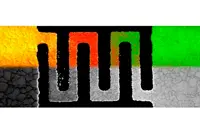Electronics News
Archive : 9 February 2015 год
 Researchers from the University of Southern California say they have made a major step forward in understanding temperatures in microelectronic devices.
Researchers from the University of Southern California say they have made a major step forward in understanding temperatures in microelectronic devices.
The team says thermal management is a struggle for the electronics industry as there is no way to measure temperature accurately at the scale of individual microelectronic devices. The mere introduction of a probe, typically larger than the device itself, affects its temperature and precludes an accurate reading. As a result, device manufacturers often rely on simulations.
"If you just simulated the temperature in a microelectronic device, the next thing you want to do is measure the temperature and see if you're right," said Matthew Mecklenburg, a senior staff scientist at the University of Southern California's Center for Electron Microscopy and Microanalysis (CEMMA). "But a persistent question has been how to make these measurements."
The team realised that, because all materials change volume depending on their temperature, the material being imaged could act as its own thermometer. In the study, aluminium was used because its thermal expansion is relatively large.
To measure the density of aluminium, the team aimed the imaging beam from a transmission electron microscope (TEM) at the aluminum, which caused the charges within the aluminum to oscillate. These charge oscillations, or plasmons, shift depending on a material's density. Using the TEM and electron energy loss spectroscopy (EELS), the team quantified the energy of the aluminum plasmon and determined its temperature with nanometre scale resolution.
"Every semiconductor manufacturer measures the size of their devices using TEMs," said Mecklenburg. "Now, in the same microscope, they can measure temperature gradients in an individual device."
The team plans to translate this technique to other materials, including silicon. By applying the approach – called plasmon energy expansion thermometry, or PEET – to other materials used in microelectronic devices, researchers will be able to map temperatures accurately while they are in operation.
Author
Graham Pitcher
Source: www.newelectronics.co.uk
 Spanish company Graphenea has won its first patent for a method it has developed to transfer large areas of graphene grown by chemical vapour deposition (CVD) from a metal foil to an insulating substrate.
Spanish company Graphenea has won its first patent for a method it has developed to transfer large areas of graphene grown by chemical vapour deposition (CVD) from a metal foil to an insulating substrate.
The company claims that, as CVD is the most promising way of growing large, high quality graphene sheets, this could be a key patent in the graphene industry.
In CVD, a source of carbon is introduced into a chamber holding a metal catalyst substrate. Under controlled conditions, the carbon forms smooth single atomic layers on all sides of the metal foil.
After growth on a metal, the graphene needs to be transferred to a useful substrate, such as an insulator. Transfer of such a large, thin film is a challenge, which often results in an imperfect final product. Graphena says its method addresses this issue.
The method starts with sheets of graphene grown on either side of a metal foil – typically copper. The first step in the transfer process is to remove one of these layers and this step is performed with a thermal release tape. Using pneumatic cylinders and accuracy valves, thermal release adhesive tape is rolled onto the graphene surface and the stack is then heated to release the tape. Subsequent steps involve depositing a sacrificial protective layer on top of the graphene, etching away the copper, transferring the graphene mechanically onto the desired substrate and dissolving the protective layer.
According to Graphenea, this method results in graphene films of excellent quality, generally surpassing that of films obtained by other transfer and etching methods.
Author
Graham Pitcher
Source: www.newelectronics.co.uk
 The European semiconductor distribution industry displayed unusual strength in the last quarter of 2014, ending the year with a healthy growth rate, according to DMASS, the Distributors' and Manufacturers' Association of Semiconductor Specialists. In its latest report, the industry group reported Q4 sales grew by 10.3% to €1.57billion, with sales for the full year reaching €6.34bn, an increase of 7.7% on 2013.
The European semiconductor distribution industry displayed unusual strength in the last quarter of 2014, ending the year with a healthy growth rate, according to DMASS, the Distributors' and Manufacturers' Association of Semiconductor Specialists. In its latest report, the industry group reported Q4 sales grew by 10.3% to €1.57billion, with sales for the full year reaching €6.34bn, an increase of 7.7% on 2013.
Georg Steinberger, chairman of DMASS, commented: "It is always good to see predictions being beaten by the reality. DMASS members did well in an increasingly steady business year and leveraged their regional strength. The 2014 results show healthy growth across the board, with very few problem zones." Sales in the UK and Ireland in Q4 grew by 12.3% to €135million.
According to Steinberger, the distribution industry has proven resilient to the overall economic slowdown in Western and Southern Europe. "This means there is a lot of market dynamics driven by innovation, rather than by macro economic effects. Distribution is not about selling commodities, but about creating demand for complex technologies. Double digit growth mainly happens with more sophisticated products, where system knowledge or software expertise are required, as well as engineering support."
Market growth was driven by RF, MOSFETs, LEDs, NAND flash and 32bit MCUs. While demand for power devices grew by 10.5% to reach €639m for the year, programmable logic sales declined by 3.1% (€484m).
Author
Graham Pitcher
Source: www.newelectronics.co.uk

